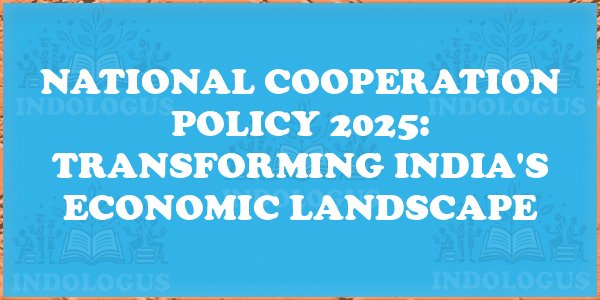The National Cooperation Policy 2025 is a revolutionary step towards reshaping India’s economic framework with cooperative values driving its growth strategy. Unveiled by Union Home Minister Amit Shah in New Delhi, this policy aims to foster inclusive development and prosperity through cooperation.
Overview
The National Cooperation Policy 2025 unveiled by Union Home Minister Amit Shah in New Delhi is a game-changer for India’s economic landscape. Rooted in cooperative values, the policy envisions inclusive development and prosperity through cooperation as a vital engine for national economic and social progress.
Background
The National Cooperation Policy 2025 builds on India’s first cooperative policy introduced in 2002 under Atal Bihari Vajpayee’s leadership. The Ministry of Cooperation, established in 2021 under Prime Minister Narendra Modi, aims to elevate the neglected cooperative sector. A 40-member drafting committee, led by Shri Suresh Prabhu, formulated the new policy after extensive consultations and engagement with key stakeholders and institutions like RBI and NABARD.
Significance
- Tripling the cooperative sector’s GDP contribution by 2034
- Engaging 50 crore citizens in cooperative activities
- Creating employment through modernized cooperative models
- Bridging rural-urban economic disparities
- Empowering marginalized groups like women, Dalits, tribals, and youth
- Shifting public perception towards cooperation for a prosperous future
Objectives of the National Cooperation Policy 2025
- Inclusive Development: Focus on rural communities, agriculture, and marginalized groups
- Employment Generation: Encourage youth participation and skill development
- Sectoral Expansion: Enter new sectors such as tourism, taxi services, insurance, and green energy
- Institutional Strengthening: Ensure professional and transparent cooperative societies
- Widespread Coverage: Establish cooperatives in every village and model cooperative villages per tehsil
Key Features
1. Grassroots Empowerment
- One Cooperative per Panchayat: Establishment of various cooperatives like PACS, dairy, and fisheries
- Model Cooperative Villages: Introduction of five model cooperative villages per tehsil through state cooperative banks
- Women’s Participation: Empowering women through initiatives like White Revolution 2.0
2. Youth-Centric and Tech-Enabled Cooperatives
- ‘Sahkar Taxi’: Introducing profit-sharing taxi services
- Technology Integration: Focus on transparent tech-driven management systems
- Tribhuvan Sahkari University: Training cooperative professionals
3. Sectoral Diversification
- New Sectors: Entry into insurance, taxi services, tourism, LPG distribution, and green energy
- PACS Expansion: Diversification into Jan Aushadhi Kendras, petrol pumps, tap water schemes, and solar energy
4. Robust Monitoring and Legal Framework
- Intervention Points: Implementing 83 intervention points with progress updates
- Monitoring System: Ensuring transparency and accountability through a cluster and monitoring system
- Legal Amendments: Provision for periodic legal updates to maintain policy relevance
5. Institutional Support and Export Potential
- Global Market Access: Establishing National Cooperative Exports Limited
- Equal Treatment: Providing equal status to scheduled cooperative banks
- Promoting Cooperation: Encouraging collaboration among cooperatives
Key Takeaways for Competitive Exams
- The National Cooperation Policy 2025 aims to transform India’s economic landscape by promoting cooperation and inclusivity
- Key objectives include inclusive development, employment generation, sectoral expansion, institutional strengthening, and widespread coverage
- Focus areas include grassroots empowerment, youth-centric initiatives, sectoral diversification, robust monitoring, and institutional support
- Students preparing for competitive exams should be familiar with the objectives and key features of the National Cooperation Policy 2025 for a comprehensive understanding of India’s cooperative sector




